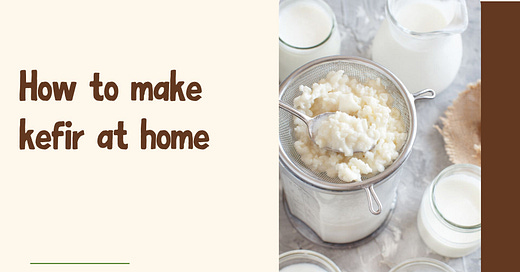Welcome to Raw Milk Mama, a newsletter about food freedom, our food systems, and how to create local food security in our communities. Sign up here for weekly posts, or keep reading...
This is a quick tutorial on how to make kefir.
Several people have asked me recently about kefir and how to make it. This quick guide will give you the information you need to get started.
Remember, you are your own expert. You know your body best and you know what works for you.
This provides information from my 15+ years of experience with making my own kefir. But you do you!
To get started, find a source of kefir “grains.”
These are not really grains. They are symbiotic colonies of probiotic yeasts and bacteria.
Whether you’ve ever made it or not, it is fairly simple to make.
This doesn’t mean that you will always get a perfect batch. In fact, expect that sometimes you won’t.
It took me a few weeks of experimentation to figure out exactly how I liked it and to get it consistently the right flavor.
Some important variables to consider are:
Ambient temperature
Time you are letting it sit
How much of the culture you use
What type of milk you are using
How old is the milk you are using
A few things not to do:
Don’t use ultra pasteurized milk for this. It won’t work. The high heat in ultra pasteurized milk causes the proteins to completely denature and they don’t make good cheese, yogurt or kefir. Just don’t.
Don’t leave it wide open. Keep it covered, even if you use a cheese cloth. But I recommend a lid.
Don’t leave it too long. Keep an eye on it and if you see it separating into curds and whey, strain it as soon as possible.
Don’t overly stress over it. Kefir grains are resilient. Kefir is good in many stages. If you need to take a break, give the kefir grains fresh milk and pop them in the fridge for a few weeks to a few months, occasionally giving them fresh milk. When you are ready to use them again, get them out, give them fresh milk and let them warm up. You might need a couple of cycles to get them active again, but be patient.
The history of kefir is absolutely fascinating. It is complete with love stories, spies, kidnapping and ransom. Read more about the history here.
And remember, the history of raw milk in America is riddled with lies, propaganda, and corporate interests. Try to find a source of clean, grassfed raw milk to make your kefir.
Have you ever made or had kefir before? Share your experience in the comments.
Bon Apetit!
About Raw Milk Mama: I believe in the freedom to feed our families how we see fit. I also see the direction that our country is going--no one wants to live in a world where food scarcity is a constant reality. It's time to take back our food systems so they serve us, not monopolistic corporations.





I'm making my own for the first time, using some of the kefir from the quart I bought through a buyers club. I hope it works out.
I made my own kefir for years after getting the grains from a local farmer. Sadly, I lost access to the raw milk and my grains turned to goo. Now that I've realized I can go to my neighboring state for easy access to raw milk I want to get my kefir going again but haven't found a source for the grains. Does anyone have any tips on where to get the grains again? Can you order them online? I was also curious what you thought about store bought kefir? I read some labels and it looks like the store bought stuff is made from pasteurized milk. Not sure how that works.